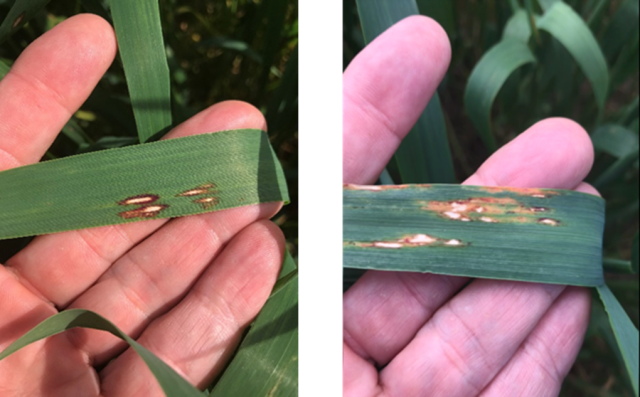Red Leather Leaf - a new disease in WA oats

At a glance
- Red leather leaf (RLL) was only confirmed in WA in 2021, but it is the most common and severe disease of oats in higher rainfall regions of south-eastern Australia.
- Symptoms include distinct lesions on leaves, featuring a lighter centre with dark margin, which over time join and eventually the complete leaf can become red and leathery in appearance.
- DPIRD will be surveying oat crops for RLL in 2022 and growers can submit any suspect RLL samples to DPIRD for free testing and confirmation of the disease.
During the 2021 growing season, a new oat foliar disease Red leather leaf (RLL), caused by the fungus Neospermospora avenae, was detected in WA oat crops. It was identified during disease surveillance activities supported by GRDC and AgriFutures projects. Samples collected from oat crops near Narrogin, Piesseville and Pingelly were assessed at the DPIRD diagnostic laboratories (DDLS) and confirmed by morphological and molecular methods as RLL. This is the first record of this disease in WA oat crops, although given the geographic spread of the detections, it is likely the disease had been present for more than one season.
While the disease (or confirmation of its presence) is new to WA, it was first detected in eastern Australia (Victoria) in 1978 and is now the most common and severe disease of oats in higher rainfall regions of south-eastern Australia.
The fungus is carried on seed and infected stubble. The disease is favoured by cool, wet weather, which supports movement of the disease up the crop canopy. Symptoms include distinct lesions on leaves, featuring a lighter centre with dark margin. Over time these legions join and eventually the complete leaf becomes red and leathery in appearance. Higher rainfall and cooler weather being experienced late in winter and into spring will maximise the impact of this disease. RLL can cause significant yield and quality losses in both hay and grain oats, with damage of >10% yield loss possible in susceptible varieties during favourable seasons (Agriculture Victoria field trials).
Trial information from eastern Australia suggests that crop rotation, variety resistance (moderately susceptible or better) and registered foliar fungicides that are applied early in the disease’s development, can significantly reduce the incidence and impact of this disease.
How and where this disease will impact WA oat production is speculative at this time, however it is most likely to be a concern for oat growers in the cooler, high-medium rainfall zones of the Great Southern region where oats are more common and seasonal conditions are more favourable, particularly in winter.
To better understand the distribution of the disease in WA and the potential impact, DPIRD will be surveying oat crops for RLL in 2022 and we encourage growers to submit any suspect samples to DPIRD for free testing. This testing is being funded by GRDC and DPIRD. To submit samples, please contact plant pathologists Geoff Thomas on +61 (0)8 9368 3262 or Kylie Chambers on +61 (0)8 9690 2151.

